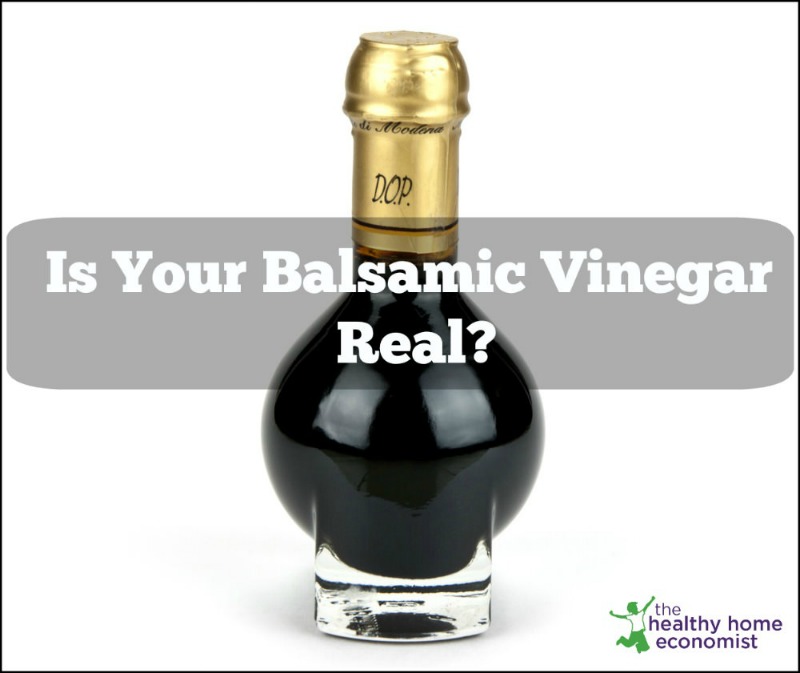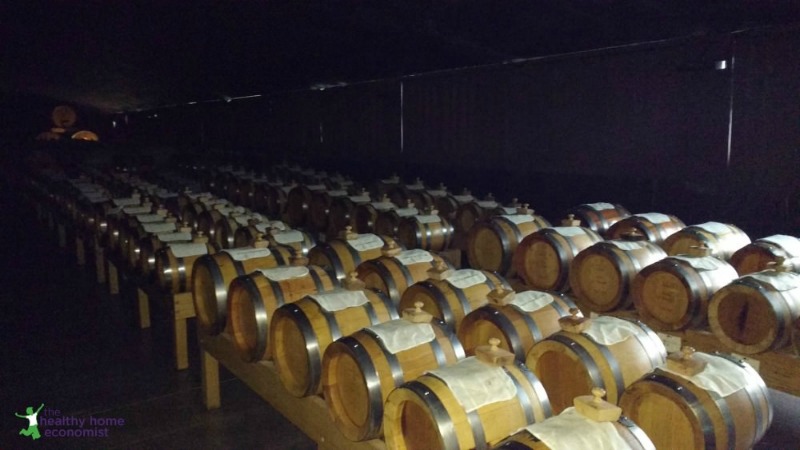Table of Contents[Hide][Show]
Traditional balsamic vinegar is an intensely flavored condiment enjoyed in the Mediterranean Diet for centuries. Most brands are not authentic, however. This article discusses how real balsamic is made and how to identify properly aged vinegar to enjoy the myriad of health benefits.
Traditional balsamic vinegar is a very dark, concentrated, health-promoting condiment with roots in Northern Italy. The real thing is nothing short of ambrosia drizzled at the table on mild tasting dishes or desserts where its intensely sweet and complex flavor can really shine.
Unfortunately, this delectable condiment is yet another victim of the quicksand of industrialized processing. The food industry’s focus on shareholders and profits at the expense of quality and consumer health is the reason why.
Nearly without exception, bottles of balsamic vinegar at the supermarket and even health food stores and gourmet shops contain cheap, hastily made concoctions that do not mirror careful ancestral practices.
This is concerning as many people today are attempting to follow a more Mediterranean style diet to improve health and wellness. Balsamic vinegar is an important condiment within this food philosophy. It appears that most people, even chefs, don’t realize that what they are using is not authentic and possibly harmful.
Known as industrial balsamics, these liquids contain few to no probiotics and beneficial enzymes. They also lack the concentrated nutrition of authentically made sweet, dark vinegar. Hence, any health benefits are lost when consumers use these modern-day versions as a substitute.
Common Balsamic Vinegar Additives
Most concerning is the adulteration of these industrial balsamics with additives and chemicals that render them harmful to consume. Some of the worst are GMO brown sugar, thickeners, and caramel coloring, a possible human carcinogen according to researchers from Johns Hopkins University. (1)
Other manufacturers simply dilute their brands with wine vinegar. This mimics a common practice where food manufacturers blend extra virgin olive oil with cheaper vegetable oils such as sunflower, soy or canola.
Worse, the label misleadingly identifies the product only as “balsamic vinegar”. Thus, it is solely up to the consumer to learn to distinguish real balsamic vinegar from fake. Reading labels closely helps accomplish this goal. In addition, understanding the traditional manufacturing of balsamic vinegar prevents getting scammed!
How is Balsamic Vinegar Made?
I fell in love with REAL balsamic vinegar during a memorable trip to Italy with Jovial Foods in the Fall of 2015. Along with several friends and one of my children who were in middle school at the time, we experienced firsthand some of the most enduring Italian culinary traditions.
The making of balsamic vinegar is one of these time-honored practices that commences with the careful cultivation of sweet, late harvested and locally grown grapes. Farmers cultivate these white grapes, usually the Lambrusco and Trebbiano varieties, on beautiful vineyards in Modena, Italy.
In this location, the climate is ideal for growing fruit with the necessary flavor and other characteristics to produce perfect balsamic vinegar.
I took the stunning photo below while visiting a vineyard in Modena that produces balsamic vinegar.

Sadly, while visiting this vineyard, one of the owners told me that unpredictable weather patterns in recent years are starting to negatively affect balsamic vinegar production. This is a worrisome development for those of us who love this ancestral condiment!
Fermented Grape Must
Once farmers harvest the white grapes, they press them into grape must. This fresh juice is complete with juice, skin, seeds, and stems. Artisans cook the must down over a direct flame by about half to the perfect concentration of syrup.
At this point, a small amount of existing balsamic vinegar is added. This probiotic inoculant initiates the fermentation process, which takes about three weeks.
The young syrup then slowly matures and becomes further concentrated for a minimum of 12 years. The aging occurs in successively smaller, wooden barrels. Craftsmen make the casks out of different types of wood such as oak, chestnut, cherry, juniper, and mulberry. This allows the vinegar to progressively take on the complex flavors of the casks.
The barrels sit in a room such as the one pictured below where workers carefully control the light, temperature, and humidity.
25 and 50 year aged balsamic vinegar is also common. Some bottles are a century or more old. As you can imagine, they are astronomically expensive too.
The longer balsamic ferments, the better the flavor. Enhanced potency of the enzymes, nutrition, and probiotics is also a possibility, although I could not find any solid research to support this.
The farm I visited carefully segregated barrels by year as you can see in the photo below.

What is Balsamic Vinegar Made Of?
You have probably realized by this point that authentic balsamic vinegar contains grape must as the single ingredient. The label might also say “cooked grapes”.
If it contains anything else, it is fake. End of story. There is more to identifying real balsamic vinegar though. More on this below!
To give you some idea of how difficult it is to source authentic balsamic vinegar aged for a minimum of 12 years, I searched high and low for a quality brand in the stores in my area. Fresh Market carried the best brand (Colvita) I could find and it was still fake!
The bottle listed the ingredients as organic wine vinegar and organic grape must. The company states that the amount of wine vinegar is significant at up to 50% of the total volume.
Wine Vinegar vs Balsamic Vinegar
Why is diluting balsamic vinegar with wine vinegar problematic? While not an unhealthy practice as long as other additives like sugar or caramel color are not present, dilution with wine vinegar renders it a cheaper and less healthy product.
The wine vinegar is young, meaning that it ferments for only a short period of time. Hence a balsamic vinegar blended with wine vinegar does not offer the probiotic and enzymatic value of 100% balsamic vinegar. The flavor doesn’t even come close to the real thing either.
When you use real balsamic vinegar, only a few drops is usually enough! Yes, the flavor is that intense!
Much more is needed with diluted versions. Hence, is it really worth it, in the long run, to get the diluted stuff even if it only contains wine vinegar as the single additional ingredient? You use so much more that you don’t really save anything in the long run. However, you give up a lot with regard to food flavor and enjoyment.
 Balsamic Vinegar Health Benefits
Balsamic Vinegar Health Benefits
Because balsamic vinegar is a fermented “live” food, it adds numerous beneficial substances to a meal. Some of these are common to fermented foods in general while others are unique.
Enzymes and Probiotics
A primary benefit common to all live fermented foods is the addition of enzymes and probiotics to a meal that may consist of mostly cooked foods.
Hence, individuals who eat these foods typically experience fewer symptoms of digestive discomfort such as bloating or heartburn. Eating these types of foods also allows for optimal nutrient absorption. Regular consumption is supportive of a high level of intestinal health.
Melanoidins
Melanoidins are beneficial compounds formed during the years-long fermentation process of balsamic vinegar. They are high molecular weight, brown-colored, nitrogen-containing substances created when the amino acids in the grape must begin to react with each other.
Known as the Maillard reaction, this chemical process reduces sugars and gives balsamic its distinctive browned color and flavor. The journal Food and Chemical Toxicology found that melanoidins inhibit oxidative stress and toxicity to the cells (cytotoxic) within the gastric environment. (2)
Abundant Polyphenols
Polyphenols are powerful antioxidants found in many foods. They are particularly prevalent in foods common to the Mediterranean such as olive oil and traditionally-made balsamic vinegar.
The Journal of Nutritional Science and Vitaminology confirms the abundant presence of these substances in balsamic vinegar. Researchers observed that the presence of this food reduced the concentrations of intracellular triglycerides. It also optimized total cholesterols by inhibiting LDL oxidation. These, in turn, reduced foam cell formation, which is fatty cells (macrophages) that indicate plaque build-up in the arteries and thus herald the onset of early-stage atherosclerosis (heart disease). (3)
There are likely numerous other helpful substances and biological benefits to consuming balsamic vinegar. Scientists will hopefully study and identify them further in the coming years.
Sulfites in Aged Balsamic Vinegar
Sulfite sensitivity is a real thing, though not a true allergy. You’ve probably heard of it before in relation to people getting headaches from red wine. Food manufacturers commonly add sulfites to maintain food color, prolong shelf-life and prevent the growth of fungi or bacteria.
I myself am sensitive to sulfites, but only if they are added, not if they are naturally occurring in small amounts. Traditional balsamic vinegar does contain some naturally occurring sulfites the same as cheese or organic red wine. In fact, ALL wine even organic contains some natural sulfites even if the label says “sulfite free”.
The “sulfite free” label really means that the product contains no artificial sulfites. Balsamic vinegar is the same. While authentic brands never contain sulfites as an additive, they will naturally contain a low level from the fermentation process.
Never Ever Heat Traditional Balsamic Vinegar
Cooking with balsamic vinegar is a big no-no. Even slight heating could destroy its distinctive flavor bouquet.
It is best to enjoy it on its own and not mixed with any other ingredients. Try a few drops on fresh berries, cheese (such as a Caprese salad) or a tiny amount drizzled on creamy desserts like pannacotta. It is also delicious on vanilla ice cream.
Incidentally, fake balsamic vinegar would NEVER taste good on ice cream. The taste would be far too acidic and not sweet enough. If the bottle of balsamic vinegar in your pantry would taste gross on a dessert, you know immediately without even looking at the label that it is fake.
How Long Does Balsamic Vinegar Last?
Since true balsamic vinegar has already fermented for 12 or more years, it will continue to stay safe for consuming indefinitely. Remember, some bottles are 150 years old!
However, to preserve that precious flavor bouquet, be sure to tightly seal the bottle after each use. Store it in a cool, dark cabinet. There is no need to refrigerate.
I bought two 3.4 ounce bottles on my visit to Modena in 2015. They lasted our family two and a half years with no degradation in flavor or quality during that time.
How to Buy Only the Real Thing
Similar to the rampant fraud that exists within the extra virgin olive oil industry, it is important to understand that most balsamic vinegar on the market is not the real thing. Buying organic is no guarantee of quality either.
Industrialized balsamic is either sugared up to unnaturally speed the fermentation process, watered down with cheap wine vinegar, adulterated with thickeners, and/or artificially augmented with chemicals to enhance the flavor/color.
Be sure the brand of balsamic vinegar you buy contains grape must as the only ingredient. For added peace of mind, buy balsamic vinegar that is independently certified (DOP) from harvest to bottling. The DOP stamp, which stands for “Denominazione di Origine Protetta” is a certification from the European Union that guarantees an ingredient’s quality, production, and place of origin. In the United States, this is an excellent brand that is what it says. Remember, you only use a few drops at a time and a few ounces can last a year or more!
If you want 100% balsamic vinegar without the added costs from EU certification, Williams Sonoma carries the real thing for a reasonable price. I’ve been using it since I ran out of balsamic vinegar from my Italy trip.
*Please note that I previously listed Napa Valley Organic Balsamic Vinegar as a good brand. It has come to my attention that this particular balsamic is now diluted with wine vinegar too. Old labels of this product indicated purity, but the newer formulation listed on the Napa Valley website indicates that it is now fake. Napa Valley no longer carries a 100% authentic balsamic vinegar.
By being a savvy consumer, you can reap the many benefits of balsamic vinegar that Mediterranean cultures enjoyed for centuries.








The organic golden balsamic vinegar has wine vinegar and grape must. This brand is clear in color does it matter? Darker color vs ligher golden color. Which one is best? I guess depending on the type if grapes used?
The brand I linked to does not have any wine vinegar in it. The ingredients are balsamic vinegar (starter) and grape must. It should be a very dark color as it is aged for years. Napa Valley has several types of balsamic vinegar and all are fake except the one I linked to. Very confusing! You have to be so on your toes with food manufacturers!
Let me check that link again. Sometimes I link to the right one and then Amazon changes it. Thanks for letting me know!
Just checked again … the link is correct and it is dark with no wine vinegar. https://amzn.to/2rMDakb
Thank you for writing this. I did not know and now understand the reason I thought balsamic vinegar was bitter. I will definitely read the labels on my vinegar from now on.
This is an update to my comment about Napa Valley balsamic vinegar.
The bottle that was in my cupboard, that I got the ingredients from, was almost empty. So, today when I went shopping I looked for some more. The label on the new bottle says “wine vinegar and grape must”, not the same as the old bottle. I looked at all their varieties and only the Organic Golden Balsamic Vinegar lists only balsamic vinegar and grape must as ingredients, all the others list wine vinegar. It is still unpasteurized and barrel aged, but I am somewhat disappointed and wanted to correct my previous information.
Ok
In the production process of making it I meant
The fresh grape must is fermented into balsamic vinegar with no intervening step.
because excess of sugar is unfavourable to alcoholic fermentation, instead acetous fermentation occurs instead.
Is balsamic vinegar fermented into alcohol first Sarah?
No it is not.
I buy Napa Valley balsamic vinegar. Its only ingredients are balsamic vinegar and grape must. It is unpasteurized, aged in cherry wood barrels and reasonably priced. We love it in homemade sodas.
Excellent! Thanks for sharing!
Great article! I loooove balsamic vinegar.
Keep up the great content!
So I just checked my bottle of Balsamic Vinegar (I am in Belgium). It says Balsamico vinegar from Modena (Italy), and it has the I.G.P indication (Indicazione Geografica Protetta), which means this specific product can only be produced in this specific region. There is however no D.O.P. label. I buy this vinegar very cheaply in my supermarket. I guess this is a very young balsamic vinegar?
The ingredient list says: wine vinegar, must (which is grape juice), coloring, potassium bisulfite
I am a bit shocked, to be honest, because I bought this product for it’s I.G.P label, thinking it must be pure.
Bummer! Definitely a fake brand. The coloring is almost certainly carcinogenic caramel coloring. It is also diluted with wine vinegar (and it is more than 50% given that it is listed first). Potassium bisulfite is used as a sterilizer … it would not be necessary if it was a truly fermented product! No probiotics and enzymes in that bottle. I hate to be the bearer of bad news, but I would suggest tossing it.
I am sad to hear that EU labeling is apparently getting as rampantly misleading as here in the US 🙁